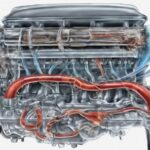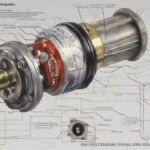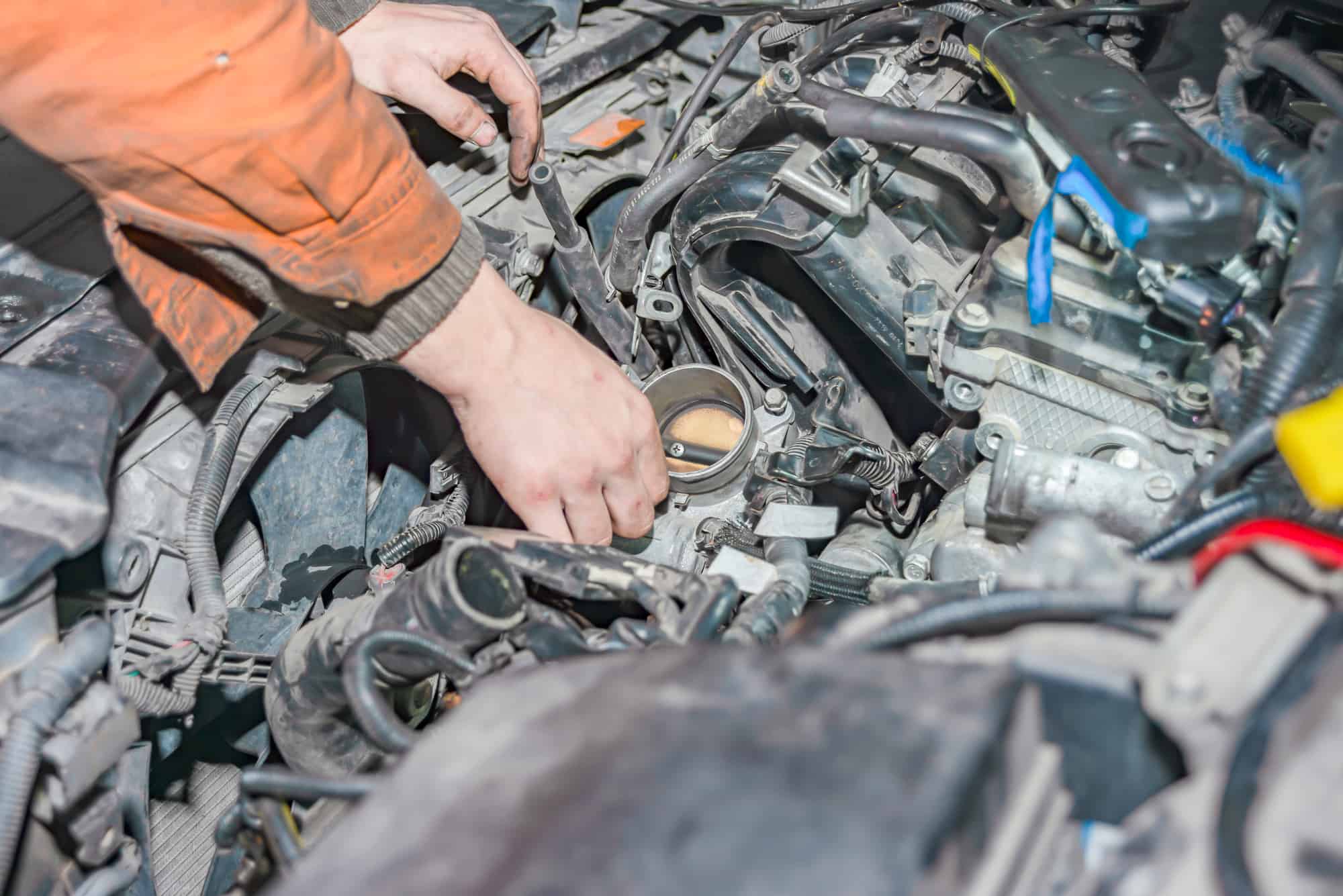A map sensor, or manifold absolute pressure sensor, is an important component of a car’s engine management system.
One of the most common symptoms of a bad map sensor is a rough idle. The engine may shake or vibrate, and it may even stall at low speeds. This is because the map sensor is not providing accurate information to the ECU, which can cause the engine to run too rich or too lean. Other symptoms of a bad map sensor include poor acceleration, decreased fuel efficiency, and stalling or hesitation during acceleration.
The MAP sensor uses a diaphragm that is exposed to the pressure in the intake manifold. As the pressure changes, the diaphragm moves, and this movement is detected by a sensor inside the MAP sensor.
As an Amazon Associate we earn from qualifying purchases.
Air pressure data is then sent as a signal to the ECU, which uses the information to adjust the fuel injection and ignition timing to optimize engine performance. If the map sensor is faulty, it can cause a range of problems that affect the engine’s performance and fuel economy.
In this article, we will take a look at the most common signs of a bad MAP sensor and how you can diagnose and fix the problem.
What Are The Signs Of A Bad MAP Sensor (9 Common Symptoms)
A failing MAP sensor will leave your engine running badly. Early symptoms of a failing MAP sensor include engine misfires, decreased fuel efficiency, rough engine idle and decreased power especially when accelerating.
When a MAP sensor fails it will cause some easy-to-spot symptoms related to engine performance. It’s worth noting that other similar problems such as faulty fuel injectors, dirty fuel filters, a faulty MAF sensor, vacuum leaks and problems with the fuel pump can also manifest themselves as hard-to-start engines or engines that are low on power, especially when accelerating.
A faulty MAP sensor may show up as an intermittent problem, and sometimes simply cleaning the sensor will resolve the issue. Sometimes it may be necessary to get an expert opinion and monitor the engine performance using real-time diagnostics.
Here are some common symptoms that may point to a faulty MAP sensor:
Symptom 1. Check Engine Light On
A bad MAP sensor can cause the check engine light to turn on because the ECU constantly monitors the sensor’s output signal. If the signal is outside of the expected range, the ECU will interpret it as a fault and turn on the check engine light to alert you that there is a problem with the sensor.
The ECU uses the data from the MAP sensor to calculate the correct air/fuel ratio and ignition timing for the engine, so if the sensor is not functioning properly, it can cause a variety of issues that can affect engine performance and emissions.
The check engine light can also be triggered by other issues related to the engine management system, such as a bad MAF sensor, so it’s important to run a diagnostic to determine the exact cause of the problem.
Symptom 2. Decreased Engine Performance
A bad MAP sensor can cause a decrease in engine performance because its job is to provide information that is used to calculate the fuel mixture and ignition timing.
If the MAP sensor is not functioning properly, the ECU may receive incorrect data or no data at all, which can cause the engine to run too rich or too lean. This can lead to a variety of issues such as decreased power, rough idling, stalling, and hesitation or surging during acceleration.
If the MAP sensor causes the ECU to adjust the air/fuel ratio and ignition timing incorrectly, this can result in reduced engine performance and increased emissions that can also cause damage to other components of the engine, such as the catalytic converter, which can be costly to repair or replace.
Symptom 3. Hard Starting
A malfunctioning MAP sensor can make it difficult for an engine to start if it messes with the fuel mixture. If the MAP sensor is not functioning properly, the ECU may receive incorrect data about the pressure of the air in the intake manifold, leading to an imbalance in the fuel mixture during the starting process. This can cause the engine to crank but not start or start but run poorly.
A bad MAP sensor can also cause the ECU to incorrectly adjust the air/fuel ratio and ignition timing during the starting process, which can make it more challenging for the engine to start, particularly in cold weather or after the vehicle has been sitting for an extended period.
Symptom 4. Poor Fuel Economy
When a MAP sensor is not functioning correctly, it can lead to poor fuel economy in a few ways. The MAP sensor provides information to the engine control module about the amount of air entering the engine, which is used to determine the correct amount of fuel to inject. If the sensor is faulty, this can lead to an imbalanced air/fuel mixture. This can cause the engine to burn more fuel than necessary, leading to poor fuel economy.
A bad MAP sensor can also cause the ECU to adjust the air/fuel ratio incorrectly, resulting in a rich fuel mixture. A rich fuel mixture can cause incomplete combustion, leading to wasted fuel and reduced fuel efficiency. The rich mixture can also cause other issues such as fouled spark plugs and increased emissions, which can further reduce fuel economy.
As part of the compensation process employed by the ECU, the fuel mixture will be constantly changing between lean and rich. This variation may cause a rough idle in some vehicles.
It is difficult to predict how rough the idle could be due to other engine conditions that could be accompanying the MAP failure. A clogged air filter, a restricted exhaust system or a vacuum leak could also impact idle performance. Unfortunately, without the MAP signal, the ECU won’t be able to compensate for such combination of issues.
Symptom 5. Engine Misfires And Rough Idling
A bad MAP sensor can cause rough idling and engine misfires due to the sensor’s role in regulating the air/fuel mixture in the engine. The MAP sensor measures the pressure inside the intake manifold and sends that information to the engine control module ECU.
If the MAP sensor is faulty, it may send incorrect or inconsistent signals to the ECU, leading to an incorrect fuel mixture. This can cause the engine to run too rich or too lean, resulting in rough idling and engine misfires.
A rich fuel mixture can cause incomplete combustion, leading to rough idling and misfires, while a lean fuel mixture can cause the engine to run hot and misfire. This can be especially noticeable during acceleration or when the engine is under load.
Symptom 6. Gas Smell Coming From The Exhaust
Another direct outcome of a bad MAP is the gas smell coming from the exhaust. A typical problem when combustion is not completed in the chamber is the fuel particles flowing through the exhaust system.
Don’t overlook this symptom because it’s more delicate than you may think. Besides the smell and possible smoke coming from the exhaust, the catalytic converters might be suffering irreversible damage as liquid particles such as unburnt fuel are very bad for catalytic converters.
What Causes A MAP Sensor To Go Bad?
A MAP sensor can go bad for several reasons, including age, wear and tear, and exposure to contaminants. Over time, the sensor’s internal components can wear out or become damaged, leading to a decrease in accuracy or a complete failure.
Exposure to heat, vibration, and other environmental factors can also cause the sensor to degrade and malfunction.
Another common cause of MAP sensor failure is contamination. The sensor’s diaphragm and other internal components can become contaminated with dirt, oil, or other debris, leading to inaccurate readings or a complete failure of the sensor.
Contamination can also cause the sensor’s electrical connections to become corroded or damaged, leading to poor signal transmission and sensor failure.
Other factors that can contribute to MAP sensor failure include exposure to moisture, electrical issues such as short circuits or voltage spikes, and damage to the sensor’s wiring or connectors.
How Does the ECU Use MAP Sensor Information?
The MAP sensor information is crucial during the air-fuel ratio calculation. The internal pressure of the intake manifold is a direct indicator of the engine’s load (amount of power used by the engine).
The ECU uses the data provided by the MAP sensor in two ways:
1. Barometric Pressure readings
Many vehicles use the MAP sensor to get barometric pressure values. This is possible because there are at least two times when the intake manifold pressure equals barometric pressure (atmospheric pressure).
The first one is just before starting the engine. When you turn the ignition switch on the ECU takes a “snapshot” of all sensor readings. The MAP pressure at this point is exactly the atmospheric pressure.
The second occasion when the MAP equals barometric pressure is during Wide Open Throttle (WOT) acceleration. For a fraction of second, the intake manifold loses its vacuum and equalizes with the atmospheric pressure.
Since the oxygen level in the air varies with altitude, the barometric pressure provided by the MAP/BARO sensor is used for corrections in the air-fuel delivery calculations.
2. Engine Load Calculations
As mentioned earlier, intake manifold pressure is directly proportional to the engine’s load. As you increase speed, the engine will burn fuel at a higher rate and will need more air to do so.
Thanks to the MAP sensor the ECU can compensate the amount of fuel needed as the engine demands it.
Each time you press the accelerator pedal you are asking for more power and thus increasing the engine’s load. The opposite is also true. As you release the accelerator pedal the throttle closes and thus intake manifold pressure decreases.
What Next – How To Diagnose And Fix a Bad MAP Sensor
If your code reader detects P0106 or P0105, then the next step is to remove and inspect the MAP sensor. You will need to check your vehicle’s repair manual for its location. Usually, the MAP sensor is directly placed on the intake manifold or near it (when it uses a vacuum hose).
Once you have located the sensor, you will need to remove it and inspect it for dirt or oil, and also make sure the wiring is not frayed or broken.
It’s very common over time for MAP sensors to get dirty. The inside of the intake manifold can become clogged up with dirt and carbonated deposits, especially in diesel engines. This dirt then transfers onto the tip of the MAP sensor and can mess up the readings.
Sometimes, you can clean a MAP sensor and this will improve performance and because it’s an easy fix it’s always worth a shot.
How To Clean A MAP Sensor:
- Locate and remove the MAP sensor from the intake manifold (refer to a repair manual if you can’t locate it). Be careful when removing it that you don’t drop it down the back of the engine or break the wiring or connector. If it’s an older car, wiring can become brittle and lose its flexibility.
- Inspect the sensor for cranks in its housing, scorch marks or problems with the connector. If it all looks good, then it may be worth cleaning.
- To clean the sensor, you’ll need a good quality MAP sensor spray cleaner. If you can’t find one then a mass air flow cleaner will do the job too.
- Spray the cleaner into the nozzle part of the sensor ( the part that pushes into the manifold). Don’t be tempted to push a screwdriver or anything pointy in there, let the cleaner do the work.
- After a few minutes, spray some more cleaner in there and gently shake the sensor, nozzle down to dislodge any dirt.
- You may need to repeat this a few times until it’s clean.
- It’s also a good idea to clean the inlet manifold too. If you are capable, then the best way to do this is to remove it from the car and give it a thorough cleaning.
- If you can’t remove it from the car, then spray a clean rag with some MAP cleaner and clean around the MAP sensor mounting hole. You may not have access to it if it’s at the back of the engine, in this case you’ll have to remove the manifold to clean it.
- Once everything is clean and dry, refit the MAP sensor, clear any engine codes and bring the car for a drive to see if the error codes reappear.
If cleaning it doesn’t work, then the best option is to just replace the sensor that is throwing up error codes.
In some cases, replacing the MAP sensor will not fix the problem as there may be a leak somewhere in the air intake system that is causing the error.
You may need to inspect the vacuum hoses, air filter or EGR valve to find the cause of the problem. Check out my article on error code P0106 and how to diagnose a faulty EGR valve for more detailed information.
Here’s a brief synopsis of what’s involved:
Vacuum hoses: perform a meticulous visual inspection of all vacuum lines, including MAP sensor, PCV, brakes vacuum booster, fuel pressure regulator, etc. Also, check the air intake hose looking for any sign of deterioration or leak. When the MAP/BARO sensor is installed directly on the intake manifold it uses a rubber o-ring type seal. Check its condition and replace as necessary.
Exhaust Gas Recirculation valve inspection: perform a thorough inspection of the EGR valve exterior, tubing, and connections. Look for possible exhaust leaks in the EGR gasket and connections. Replace the gasket and/or EGR valve if necessary.
As an Amazon Associate we earn from qualifying purchases.































My car has been idling roughly and stalling at low speeds. Could this be related to a bad MAP sensor, and how can I confirm it?
Is it possible for a DIY enthusiast to accurately diagnose a bad MAP sensor without professional diagnostic tools, and if so, how can one ensure the accuracy of such a diagnosis?